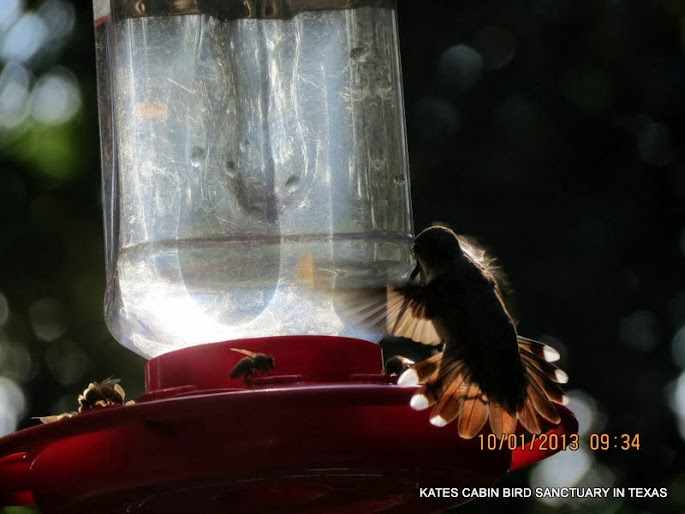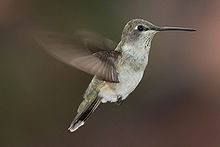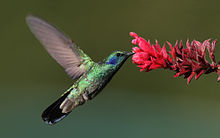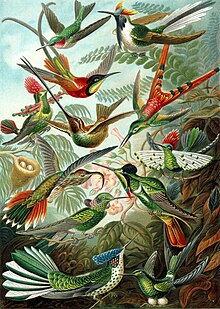
Hi Everybody!!
You are going to laugh on this one! Last Saturday Night I was intending to meet some friends and one of their friends for dinner. As I have not done this in 30 years or so, I decided to do it right! I went to the Beauty Shop and got a new Gypsy Haircut and set. I got the nails put on. I bought a pretty new blouse and put on make-up. I did not look like a wild woman in the woods anymore! On the way out, I rocked all the hummer feeders to refill the wells. When I got to the new one without a screw on jar-KABOOM-the bottom dropped out and covered me with sugar water all over my hair, makeup and new blouse. As I stood there in shock, bees started landing on my face! Some things are not meant to be. I cancelled my dinner date (as I would need a week to get ready again). I took a hot shower, put old my faded old glory robe and sat with the birds till dark. Enjoy Your Photostudies, links below:
October 1
link 1
https://plus.google.com/u/0/photos/117645114459863049265/albums/5932739241993595889

October 1
link 2:
https://plus.google.com/u/0/photos/117645114459863049265/albums/5932742085342819393

October 2
link 1:
https://plus.google.com/u/0/photos/117645114459863049265/albums/5932746512099259745

October 2
link 2:
https://plus.google.com/u/0/photos/117645114459863049265/albums/5932748188270834513

October 2
link 3:
https://plus.google.com/u/0/photos/117645114459863049265/albums/5932750406895591073

October 3
link 1:
https://plus.google.com/u/0/photos/117645114459863049265/albums/5932768227535781249

October 3
link 2:
https://plus.google.com/u/0/photos/117645114459863049265/albums/5932769892306313393

October 4
link 1:
https://plus.google.com/u/0/photos/117645114459863049265/albums/5932772342390396305

October 4
link 2:
https://plus.google.com/u/0/photos/117645114459863049265/albums/5932774681005445617

https://en.wikipedia.org/wiki/Hummingbird
Hummingbird
From Wikipedia, the free encyclopedia
| Hummingbird | |
|---|---|
 | |
| Female Black-chinned Hummingbird | |
| Scientific classification | |
| Kingdom: | Animalia |
| Phylum: | Chordata |
| Class: | Aves |
| Subclass: | Neornithes |
| Infraclass: | Neognathae |
| (unranked): | Cypselomorphae |
| Order: | Apodiformes |
| Family: | Trochilidae Vigors, 1825 |
| Subfamilies | |
Hummingbirds are birds that comprise the family Trochilidae. They are among the smallest of birds, most species measuring in the 7.5–13 cm (3–5 in) range. Indeed, the smallest extant bird species is a hummingbird, the 5-cm Bee Hummingbird. They hover in mid-air by rapidly flapping their wings 12–80 times per second (depending on the species). They are known as hummingbirds because of the humming sound created by their beating wings, which sometimes sounds like bees or other insects. To conserve energy while they sleep or when food is scarce, they have the ability to go into a hibernation-like state (torpor) where their metabolic rate is slowed to 1/15th of its normal rate.[1] When the nights get colder, their body temperature can drop significantly and thus slow down their heart and breathing rate, thus burning much less energy overnight. As the day heats back up, the hummingbirds' body temperature will come back up and they resume their normal activity.[2] They can fly at speeds exceeding 15 m/s (54 km/h; 34 mph);[3] they are also the only group of birds with the ability to fly backwards.[4] Individuals from some species of hummingbirds weigh less than a penny.
Diet and specialization for food gathering[edit]
Hummingbirds drink nectar, a sweet liquid inside certain flowers. Like bees, they are able to assess the amount of sugar in the nectar they eat; they reject flower types that produce nectar that is less than 10% sugar and prefer those whose sugar content is higher. Nectar is a poor source of nutrients, so hummingbirds meet their needs for protein, amino acids,vitamins, minerals, etc. by preying on insectsand spiders.[5]
Most hummingbird species have bills that are long and straight or nearly so, but in some species the bill shape is adapted for specialized feeding. Thornbills have short, sharp bills adapted for feeding from flowers with short corollas and piercing the bases of longer ones. The Sicklebills' extremely decurved bills are adapted to extracting nectar from the curved corollas of flowers in the family Gesneriaceae. The bill of the Fiery-tailed Awlbill has an upturned tip, as in the Avocets. The male Tooth-billed Hummingbird has barracuda-like spikes at the tip of its long, straight bill.
The two halves of a hummingbird's bill have a pronounced overlap, with the lower half (mandible) fitting tightly inside the upper half (maxilla). When hummingbirds feed on nectar, the bill is usually opened only slightly, allowing the tongue to dart out and into the interior of flowers.
While it had been believed that hummingbirds drink via capillary action, high-speed photography has revealed that a hummingbird's tongue’s tubes open down their sides, and close around nectar.[6] Hummingbirds do not spend all day flying, as the energy cost would be prohibitive; the majority of their activity consists simply of sitting or perching. Hummingbirds eat many small meals and consume as much as twelve times their body weight in nectar each day.[7] Hummingbirds digest their food rapidly due to their small size and high metabolism; a mean retention time (MRT) of less than an hour has been reported.[8] Hummingbirds spend an average of 10–15% of their time feeding and 75–80% sitting and digesting.
Hummingbirds are typically very territorial when it comes to food; once a hummingbird finds a consistent source of food such as an artificial feeder, it will fight off other hummingbirds to maintain complete dominance over the food source.
Co-evolution with ornithophilous flowers[edit]
Hummingbirds are specialized nectarivores[9] and are tied to the ornithophilous flowers they feed upon. Some species, especially those with unusual bill shapes such as theSword-billed Hummingbird and the sicklebills, are co-evolved with a small number of flower species.
Many plants pollinated by hummingbirds produce flowers in shades of red, orange, and bright pink, though the birds will take nectar from flowers of many colors. Hummingbirds can see wavelengths into the near-ultraviolet, but their flowers do not reflect these wavelengths as many insect-pollinated flowers do. This narrow color spectrum may render hummingbird-pollinated flowers relatively inconspicuous to most insects, thereby reducingnectar robbing.[10][11] Hummingbird-pollinated flowers also produce relatively weak nectar (averaging 25% sugars w/w) containing high concentrations of sucrose, whereas insect-pollinated flowers typically produce more concentrated nectars dominated by fructose and glucose.[12]
A hummingbird's pollination abilities are not always desirable. In Hawaii, for example, hummingbirds are prohibited because pollination of pineapple flowers causes hard seeds to develop in the fruit.[13]
Aerodynamics of flight[edit]
Hummingbird flight has been studied intensively from an aerodynamic perspective using wind tunnels and high-speed video cameras.
Writing in Nature, the biomechanist Douglas Warrick and coworkers studied the Rufous Hummingbird, Selasphorus rufus, in a wind tunnel using particle image velocimetrytechniques and investigated the lift generated on the bird's upstroke and downstroke. They concluded that their subjects produced 75% of their weight support during the downstroke and 25% during the upstroke. Many earlier studies had assumed (implicitly or explicitly) that lift was generated equally during the two phases of the wingbeat cycle, as is the case of insects of a similar size. This finding shows that hummingbirds' hovering is similar to, but distinct from, that of hovering insects such as the hawk moths.[15]
The Giant Hummingbird's wings beat is as low as 12 beats per second, the wings of medium-sized hummingbirds beat about 20 to 30 beats per second and the smallest can reach 100 beats per second during courtship displays.
A slow motion video has shown how the hummingbirds deal with water when they are flying. To remove the water from their heads, they shake their heads and body, similar to a dog shaking to shed water.[16]
Metabolism[edit]
With the exception of insects, hummingbirds while in flight have the highest metabolismof all animals, a necessity in order to support the rapid beating of their wings. Their heart rate can reach as high as 1,260 beats per minute, a rate once measured in a Blue-throated Hummingbird.[17] They also consume more than their own weight in nectar each day, and to do so they must visit hundreds of flowers daily. Hummingbirds are continuously hours away from starving to death and are able to store just enough energy to survive overnight.[18]
Hummingbirds are capable of slowing down their metabolism at night or at any other time food is not readily available. They enter a hibernation-like state known as torpor. During torpor, the heart rate and rate of breathing are both slowed dramatically (the heart rate to roughly 50 to 180 beats per minute), reducing the need for food.
The dynamic range of metabolic rates in hummingbirds[19] requires a corresponding dynamic range in kidney function.[20] The glomerulus is a cluster of capillaries in thenephrons of the kidney that removes certain substances from the blood, like a filtration mechanism. The rate at which blood is processed is called the glomerular filtration rate (GFR). Most often these fluids are reabsorbed by the kidneys. During torpor, to prevent dehydration, the GFR slows, preserving necessities for the body such as glucose, water and salts. GFR also slows when a bird is undergoing water deprivation. The interruption of GFR is a survival and physiological mechanism unique to hummingbirds.[20]
Studies of hummingbirds' metabolisms are highly relevant to the question of how amigrating Ruby-throated Hummingbird can cross 800 km (500 mi) of the Gulf of Mexicoon a nonstop flight. This hummingbird, like other birds preparing to migrate, stores up fat to serve as fuel, thereby augmenting its weight by as much as 100 percent and hence increasing the bird's potential flying time.[21]
Lifespan[edit]
Hummingbirds have long lifespans for organisms with such rapid metabolisms. Though many die during their first year of life, especially in the vulnerable period between hatching and leaving the nest (fledging), those that survive may live a decade or more. Among the better-known North American species, the average lifespan is 3 to 5 years. By comparison, the smaller shrews, among the smallest of all mammals, seldom live more than 2 years.[22] The longest recorded lifespan in the wild is that of a female Broad-tailed Hummingbird that was banded (ringed) as an adult at least one year old, then recaptured 11 years later, making her at least 12 years old. Other longevity records for banded hummingbirds include an estimated minimum age of 10 years 1 month for a femaleBlack-chinned similar in size to Broad-tailed, and at least 11 years 2 months for a much larger Buff-bellied Hummingbird.[23]
Range[edit]
See also: List of Apodiformes by population
Hummingbirds are restricted to the Americas from southern Alaska to Tierra del Fuego, including the Caribbean. The majority of species occur in tropical and subtropical Central and South America, but several species also breed in temperate climates and some hillstars occur even in alpine Andean highlands at altitudes of up to 5,200 metres (17,100 ft).[24] The greatest species richnessis in humid tropical and subtropical forests of the northern Andes and adjacent foothills, but the number of species found in theAtlantic Forest, Central America or southern Mexico also far exceeds the number found in southern South America, the Caribbean islands, the United States and Canada. While fewer than 25 different species of hummingbirds have been recorded from the United States and fewer than 10 from Canada and Chile each,[25] Colombia alone has more than 160[26] and the comparably small Ecuadorhas about 130 species.[27] The migratory Ruby-throated Hummingbird breeds in eastern North America, while the Black-chinned Hummingbird, its close relative and another migrant, is the most widespread and common species in the southwestern United States, while the Rufous Hummingbird is the most widespread species in western North America.[28]
Migration[edit]
Most hummingbirds of the U.S. and Canada migrate south in fall to spend the winter in northern Mexico or Central America. A few southern South American species also move to the tropics in the southern winter. A few species are year-round residents in the warmer coastal and southern desert regions on the USA. Among these is Rufous Hummingbird, a winter resident in Florida, parts of the Gulf coast, and up to the lowlands of coastal South Carolina/Georgia, and Anna's Hummingbird, a common resident from California inland to southern Arizona and north to southwestern coastal British Columbia.
The Rufous Hummingbird is one of several species that breed in North America and are wintering in increasing numbers in the warm subtropical southeastern United States, rather than in tropical Mexico. The Rufous Hummingbird nests farther north than any other species and must tolerate occasional temperatures below freezing on its breeding grounds. This cold hardiness enables it to survive brief temperatures below freezing, provided that adequate shelter and feeders are available.
Superficially similar birds[edit]
Some species of sunbirds of Africa, southern and southeastern Asia, and Australia resemble hummingbirds in appearance and behavior, as do perhaps also the honeyeaters of Australia and Pacific islands. These two groups, however, are not related to hummingbirds; their resemblance is due to convergent evolution.[29]
Sonation during display dives[edit]
The outer tail-feathers of male Anna's Hummingbird (Calypte anna) vibrate during display dives and produce a loud chirp. When courting, the male ascends some 30m before diving over an interested female at high speed and producing a high-pitched sound. Experiments showed that the birds could not make the sound when missing their outer tail-feathers, and that those same feathers could produce the dive-sound in a wind tunnel. The bird can sing at the same frequency as the tail-feather chirp, but its weak syrinx is not capable of the same volume. Many other species of hummingbirds also produce sounds with their wings or tail, including the wings of the Broad-tailed Hummingbird, Rufous Hummingbird, Allen's Hummingbird, Streamertail, as well as the tail of the Costa's Hummingbird and the Black-chinned Hummingbird.[30]
Systematics and evolution[edit]
In traditional taxonomy, hummingbirds are placed in the order Apodiformes, which also contains the swifts. However, some taxonomists have separated them into their own order, Trochiliformes. Hummingbirds' wing bones are hollow and fragile, making fossilization difficult and leaving their evolutionary history poorly documented. Though scientists theorize that hummingbirds originated in South America, where there is the greatest species diversity, possible ancestors of extant hummingbirds may have lived in parts of Europe to what is southern Russia today.[31]
There are between 325 and 340 species of hummingbird, depending on taxonomic viewpoint, divided into two subfamilies, the hermits (subfamily Phaethornithinae, 34 species in six genera), and the typical hummingbirds (subfamily Trochilinae, all the others). However, recent phylogenetic analyses suggest that this division is slightly inaccurate, and that there are nine major clades of hummingbirds: the topazes andjacobins, the hermits, the mangoes, the coquettes, the brilliants, the Giant Hummingbird (Patagona gigas), the mountain-gems, the bees, and the emeralds.[32] The topazes and jacobins combined have the oldest split with the rest of the hummingbirds. The hummingbird family has the second greatest number of species of any bird family on Earth (after the tyrant flycatchers).
Fossil hummingbirds are known from the Pleistocene of Brazil and the Bahamas; however, neither has yet been scientifically described, and there are fossils and subfossils of a few extant species known. Until recently, older fossils had not been securely identifiable as those of hummingbirds.
In 2004, Dr. Gerald Mayr of the Senckenberg Museum in Frankfurt am Main identified two 30-million-year-old hummingbird fossils and published his results in the journal Science.[33] The fossils of this primitive hummingbird species, named Eurotrochilus inexpectatus ("unexpected European hummingbird"), had been sitting in a museum drawer in Stuttgart; they had been unearthed in a clay pit at Wiesloch–Frauenweiler, south of Heidelberg, Germany, and, because it was assumed that hummingbirds never occurred outside the Americas, were not recognized to be hummingbirds until Mayr took a closer look at them.
Fossils of birds not clearly assignable to either hummingbirds or a related, extinct family, the Jungornithidae, have been found at theMessel pit and in the Caucasus, dating from 40–35 mya; this indicates that the split between these two lineages indeed occurred at that date. The areas where these early fossils have been found had a climate quite similar to that of the northern Caribbean or southernmost China during that time. The biggest remaining mystery at the present time is what happened to hummingbirds in the roughly 25 million years between the primitive Eurotrochilus and the modern fossils. The astounding morphological adaptations, the decrease in size, and the dispersal to the Americas and extinction in Eurasia all occurred during this timespan. DNA-DNA hybridization results[34] suggest that the main radiation of South American hummingbirds took place at least partly in the Miocene, some 12 to 13 million years ago, during the uplifting of the northern Andes.
In 2013, a 50-million-year-old fossil bird unearthed in Wyoming was found to be a predecessor to both hummingbirds and swifts before the groups diverged.[35]
Wing structure and colors[edit]
Many of the hummingbird species have bright plumage with exotic coloration. In many species, the coloring does not come frompigmentation in the feather structure, but instead from prism-like cells within the top layers of the feathers. When light hits these cells, it is split into wavelengths that reflect to the observer in varying degrees of intensity. The Hummingbird feather structure acts as a diffraction grating. The result is that, merely by shifting position, a muted-looking bird will suddenly become fiery red or vivid green. However, not all hummingbird colors are due to the prism feather structure. The rusty browns of Allen's and Rufous Hummingbirds come from pigmentation. Iridescent hummingbird colors actually result from a combination of refraction and pigmentation, since the diffraction structures themselves are made of melanin, a pigment.[36]
a








...this is brendasue signing off from Rainbow Creek. See You next time!

O+O










No comments:
Post a Comment
Hi Everybody! Please say hello and follow so I know you are here! Due to the inconsideration of people trying to put commercials on my blog comment area, I have restricted use of anonymous posts. Sorry that some hurt all.
My public email is katescabin@gmail.com No spammers or trolls